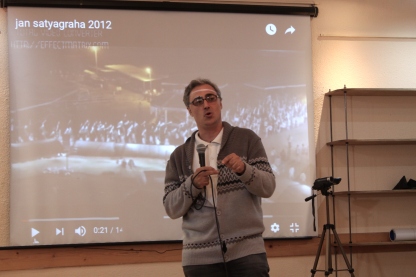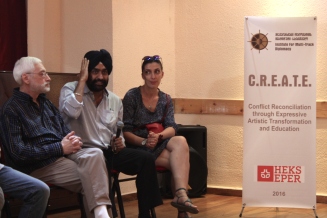Second meeting of discussion club was focused on Creative Satyagraha. Satyagraha is a word of Indian origin and means “holding firmly onto truth”. Gandhi considered truth as a main value. Satyagraha is a method of nonviolent resistance developed by Mahatma Gandhi. Irakli Kakabadze introduced its main principles to the discussion club participants. He spoke about indian way of nonviolent action, which led to dramatic changes in the country and on the international level. He said that Gandhi way of resistance influenced other activists, such as Nelson Mandela and Martin Luther King Jr. It was a great impulse in 1960s. Irakli Kakabadze also talked about contemporary non-violent practice in India, which brings huge changes to the local communities.

He discussed example of Ekta Parishad. It is a nonpartisan organization, social movement, which gained influence not only in India, but also all over the world. Ekta Parishad uses creative methods to mobilize people and advocate their rights. The organization helps poorest people of India, who are deprived lands and therefore, opportunity to grow food for their families. With active campaigns of the organization 1.5 million people received back their lands. Its leader – Rajagopal has already visited Georgia three times to share his experience to Georgian counterparts.

Guest from India – Kiranjit Singh Bawa – representative of The Anād Foundation talked about social and cultural challenges in India; forms of the protests used by activists and measures taken by the government against them. He also stated that sharing is part of Indian culture. Their religion requires donation of 10% of the income to the charity. Mr. Bawa also talked about technological progress and its impact on the development of social movements, for the mobilization of the people and for quick and effective dissemination of the information.
Alexander Rusetski shared experience of the Polish nonviolent resistance against Soviet government. They used various methods, including large-scale walks. They applied other creative methods: they used to turn their TV sets to the side of the street; started to switch on and off the lights, simultaneously, on the appointed time. In this way they demonstrated their unity and protest against government. International school of protest culture should be created. We should learn from the traditional Georgian culture and other countries.
 David Amirejibi – When Gandhi appeared, the world could not understand with whom they were dealing. Because Gandhian protest appeared deeper than the one which had been existed before. Protest of Gandhi was art itself. It included dance, meditation, demonstration of inner essence, which invisibly unites India. India is a great power. We should not see only forms of social protest there. Instead we should see the reasons – what and why India protests. It is because they have own being that should be saved. Refugees lost this essence – homeland. But the gave not lost land or sea. Some power conquers us and destroys our essence. We need Gandhi to realize what we protect and what we protest. India does not exist without language, culture and traditions. Similarly, Georgia does not exist without them either. Language of culture and art talks about out essence – I think we should learn India into the language.
David Amirejibi – When Gandhi appeared, the world could not understand with whom they were dealing. Because Gandhian protest appeared deeper than the one which had been existed before. Protest of Gandhi was art itself. It included dance, meditation, demonstration of inner essence, which invisibly unites India. India is a great power. We should not see only forms of social protest there. Instead we should see the reasons – what and why India protests. It is because they have own being that should be saved. Refugees lost this essence – homeland. But the gave not lost land or sea. Some power conquers us and destroys our essence. We need Gandhi to realize what we protect and what we protest. India does not exist without language, culture and traditions. Similarly, Georgia does not exist without them either. Language of culture and art talks about out essence – I think we should learn India into the language.
Other participants of the discussion club also expressed their attitude about importance of nonviolent actions and communication, which drives society to the changes. Only peaceful dialogue, spirituality can transform relationships and build trust among peoples. Violence and a aggression can’t resolve problems. It causes further complications and breaks bridges. Love and communication can lead to progress, positive changes on any level, in every sphere of the life.


















Leave a comment